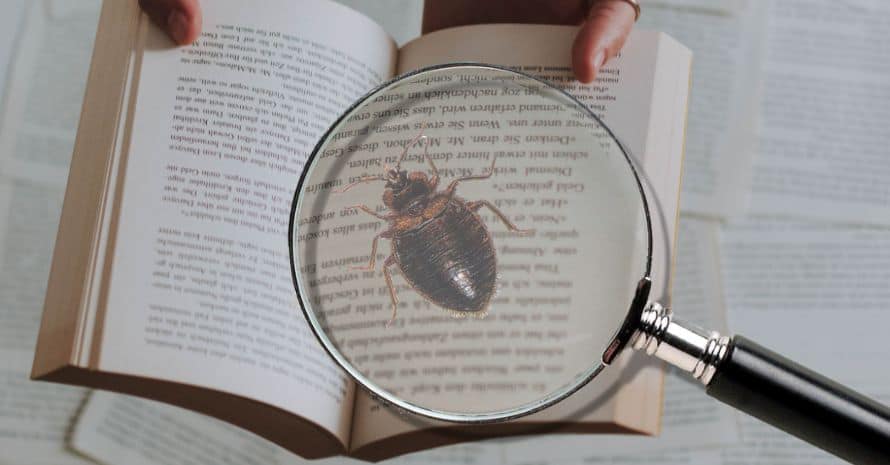If you’re one of those people who love to curl up with a good book, you might want to think twice before snuggling up with your favorite novel. That’s because it’s becoming more and more common to bed bugs from library books and bookstores across the country.
These parasites are most active at night and are experts at hiding in tiny cracks and crevices. This makes them difficult to spot and get rid of. If you suspect you have bed bugs in your collection, you’re wondering how to treat books for bed bugs.
[wpsm_titlebox title=”How to Treat Books for Bed Bugs” style=”main”]
The best way to treat books for bed bugs would be to place the book in a ziplock bag and then put the ziplock bag in the freezer. This will kill both the parasites and the eggs they have laid.
But what if you have a lot of books infested with bedbugs? Read about that below.
[/wpsm_titlebox]
Signs of Bed Bugs in a Book
Anyone who has dealt with bed bugs can tell you these pests are tough to spot. They’re small and flat and blend in easily with their surroundings, making them difficult to see with the naked eye. However, there are a few signs that you can look for that may indicate the presence of bed bugs in your book. And we all, of course, habitually imagine them in beds, but can bed bugs hide in books?
One of the most obvious signs of bed bugs is the presence of small, dark spots on your book’s pages. These spots are actually the bed bugs’ feces and can be a tell-tale sign that these pests are present. Another sign to look for is small, reddish-brown stains on your book’s pages. These stains are bed bug blood and are usually left behind after the bugs have fed.

How Do Bed Bugs Breed in Books?
Bed bugs are small, elusive, and can breed rapidly. Unfortunately, they can also infest books.
These insects are attracted to warmth and darkness. Books provide the perfect environment for bed bugs to hide and breed. The bed bugs paper pages of books offer many small nooks and crannies for them to hide. The darkness inside also provides bed bugs with the perfect environment to avoid detection.
They are usually active at night and hide in cracks and crevices during the day. Bed bugs have been around for centuries, and their numbers have increased in recent years.
Bed bugs breed by laying eggs. A female bed bug can lay up to 500 eggs in her lifetime. The eggs are small and white and are often found in cracks and crevices. They can survive in a wide range of temperatures and can go without food for a long time.
How Long Can They Live In Them?
Books are often enticing to bed bugs because they provide ample hiding spots and are often located near where people sleep. Additionally, these parasites are attracted to the smell of human skin, which is often present in books that people have handled. This is especially true of library book bed bugs.
They can live for several months without food but, eventually, die of starvation. However, they can live much longer if they have a regular food source.
How to Treat Books for Bed Bugs: Easy Extermination Guide
Bed bugs are experts at hiding, so they can be hard to spot. But if you look closely, you might see them in the creases of your book’s spine or the folds of its pages. There are many ways that a person can treat their books for bed bugs. There are even written on this topic about bed bugs books treatment. But this article will cover the effective ways to do so.

Step 1. Carefully inspect
Inspect your books carefully for signs of bed bugs. Look for small, dark spots on the pages or covers. These spots are bed bug droppings and can be a sign that you have an infestation.
Step 2. Isolate the books
If you notice an infestation in your home, the first step you should take is to isolate the books.
You can do this by sealing them in a large plastic bag. This will prevent the parasites from spreading to the rest of your home.
Step 3. Ventilate your books
Take the affected books outside and place them in the sun for a few hours. The heat will kill the bed bugs.
Step 4. Treat it with cold
If you can’t take the books outside, you can place them in a plastic bag and put them in the freezer for a few days. This will also kill the parasites.
Step 5. Vacuum the books
Also, you can vacuum them to remove any bed bugs on the surface. Be sure to vacuum the inside and outside of the books, as well as the spine.
Step 6. Treat the books to heat
Use a steam cleaner on all infested areas, including furniture, floors, cracks, and crevices.
Step 7. Treat the books with insecticides
The final step in getting rid of bedbugs is to use a bedbug-specific insecticide. Follow the instructions on the bottle and apply the insecticide to all areas where you’ve seen bedbugs.
Step 8. Vacuum again
After treating the books with heat or insecticides, vacuum them again to remove any dead bugs. Next, vacuum your entire home, paying special attention to any cracks or crevices where parasites might hide.
Step 9. Check for bed bugs regularly
Even after you have treated the books, you should check for bed bugs regularly. This will help you catch any new infestations early.
Step 10. Professional pest control
If you have a severe infestation, it’s best to consult a professional pest control company to get rid of the bed bugs.

How to Prevent Bedbugs in Books
If you have these pests in your home, you may wonder can bed bugs get into books and how to prevent them from infesting your books. While bedbugs can be difficult to control, there are some things you can do to ward off them from your books.
First, it’s important to keep your home clean and clutter-free. They are attracted to dirty environments and can easily hide in clutter. Vacuum regularly and declutter your home to reduce the risk of bedbugs.
Second, inspect your books carefully before bringing them into your home, especially used books bed bugs. If you suspect that a book may be infested with bedbugs, do not bring it into your home. Scrutinize used literature before purchasing, and look for signs of parasites such as small brown spots or exoskeletons.
Third, vacuum your bookshelves regularly. This will help to remove any bedbugs that may be hiding there.
Finally, consider using insecticide dust or sprays on your books. This will kill any bedbugs that may be present and help prevent future infestations.

FAQ
If you are facing this problem for the first time, you may have some additional questions. Read on to discover more information!
How common are bedbugs in books?
Although bedbugs are most commonly associated with dirty mattresses and furniture, they can also be found in books. In fact, they are attracted to anything that provides them with a warm, dark place to hide, which is why they are often found in libraries and second-hand bookstores. While these insects are not dangerous, they can be extremely annoying, and their bites can be quite itchy. If you suspect that there may be bedbugs in a book that you are reading, it is best to inspect the book before taking it home.
Can you get bedbugs from books?
The simple answer is yes; you can get bedbugs from books. However, it is important to note that bedbugs are not limited to books and can be found in a variety of places, such as your bed, furniture, clothing, and other objects.
How Long can bed bugs live in a book?
Bed bugs can live for up to a year without feeding, but they will eventually die if they do not have a blood meal.
Can you kill microwave books bedbugs?
Microwaves can kill bed bugs if they’re exposed to the right intensity and duration of heat. Not all microwaves are created equal. Some models may not get hot enough to kill parasites, so do your research before using this method. Keep in mind that microwaving your infested items will only kill the insects that are exposed to the heat. If any bed bugs are hiding in cracks or crevices, they’ll survive and will need to be dealt with using another method.
Deal With Bed Bugs Right Away
If you love books, the thought of bed bugs infesting them is enough to make your skin crawl. Bedbugs are hitchhikers, and they’re very good at it. They can move from one person to another on clothing or luggage and move onto books, including bed bugs libraries. Once they’re in a new location, they start to feed. And while they don’t carry any diseases, their bites can be itchy and annoying. But don’t let the bed bugs bite – take steps to protect your books and your home from these pesky pests.
Have you ever had bed bugs in your books? How did you cope with them? Share your experiences in the comments!

